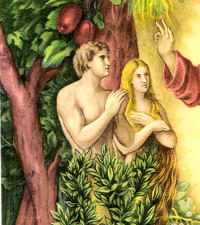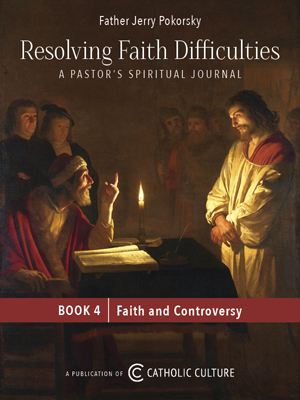Lent: February 24th
Saturday of the First Week of Lent; Ember Saturday
» Enjoy our Liturgical Seasons series of e-books!
It is Ember Saturday of Lent or Spring Embertide. See Contemporary Observation of Ember Days and Lenten Ember Days for more information.
The traditional Station Church today is at St. Peter's Basilica. In this basilica at the Vatican priestly ordinations were formerly held on Ember Saturday (or early Sunday morning preceded by a long vigil). The 1962 Missal includes three extra Lessons, a relic of those read formerly during the night. The current Lectionary's first reading from Deuteronomy 26:16-19 is one of the readings from the former missal.
Meditation on the Liturgy—Spring Ember Days
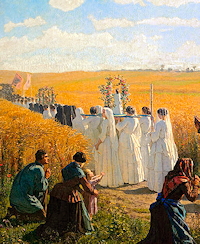 According to the tradition of the Church, the first week of Lent is the week of Spring Ember Days. Ember Days are specifically a tradition of the Church in Rome, its roots partly to be found in the Old Testament — where for example the prophet Zechariah attests four seasons of fasting in the years — and partly in the tradition of pagan Rome, with its festivals of seedtime and harvest still recalled in our own days. So we have this fine combination of creation and biblical history, a combination which is a sign of true catholicity. In the celebrations of these days we receive the year from the hand of God, receive our time from the Creator and Redeemers, and confide sowing and harvesting to his goodness, thanking him for the fruit of the earth and our work. The celebration of the Ember Days corresponds to the fact that "the creating waits with eager longing for the revealing of the sons of God" (Rom 8:19): through our prayer, creation enters into the Eucharist, has part in the praise of God.
According to the tradition of the Church, the first week of Lent is the week of Spring Ember Days. Ember Days are specifically a tradition of the Church in Rome, its roots partly to be found in the Old Testament — where for example the prophet Zechariah attests four seasons of fasting in the years — and partly in the tradition of pagan Rome, with its festivals of seedtime and harvest still recalled in our own days. So we have this fine combination of creation and biblical history, a combination which is a sign of true catholicity. In the celebrations of these days we receive the year from the hand of God, receive our time from the Creator and Redeemers, and confide sowing and harvesting to his goodness, thanking him for the fruit of the earth and our work. The celebration of the Ember Days corresponds to the fact that "the creating waits with eager longing for the revealing of the sons of God" (Rom 8:19): through our prayer, creation enters into the Eucharist, has part in the praise of God.
In the fifth century however, the Ember Days took on another dimension, becoming feasts of the spiritual harvest of the Church, feasts of Holy Orders. The arrangement of stational churches for these three days is very significant: Wednesday, Saint Mary Major; Friday, the Church of the Twelve Apostles; Saturday, St. Peter's. On the first day, the Church presented the ordinands to Our Lady, to the Church in person. "Sub tuum praesidium confugimus" (We fly to your protection), a Marian prayer of the third century, comes to mind here when we meditate on this action. The Church confides her ministers to the Mother: "Behold your mother". This word from the Cross encourages us to seek refuge close to our Mother. Under Our Lady's mantle, we are safe. In all our difficulties we can turn with immense faith to our Mother, we venture to take up our service.
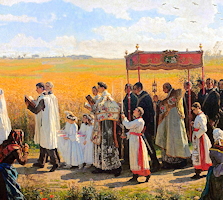 The Friday was the day of the Twelve Apostles' church. As "fellow-citizens of the saints and servants of God" we "are built upon the foundation of the apostles and prophets" (Eph 2:19-20). Only in the context of the apostolic succession, of the faith of the Apostles and of the apostolic structure of the Church, with a true priestly system, that is, can we construct the living temple of God. The ordinations themselves took place during the night of Saturday, with a view to Sunday morning in St. Peter's. Thus the Church expressed the unity of the priestly system in union with Peter, as Jesus at the beginning of his public life had called Peter and his "partners" (Lk 5:10), after he had been teaching from Simon's boat.
The Friday was the day of the Twelve Apostles' church. As "fellow-citizens of the saints and servants of God" we "are built upon the foundation of the apostles and prophets" (Eph 2:19-20). Only in the context of the apostolic succession, of the faith of the Apostles and of the apostolic structure of the Church, with a true priestly system, that is, can we construct the living temple of God. The ordinations themselves took place during the night of Saturday, with a view to Sunday morning in St. Peter's. Thus the Church expressed the unity of the priestly system in union with Peter, as Jesus at the beginning of his public life had called Peter and his "partners" (Lk 5:10), after he had been teaching from Simon's boat.
The first week of Lent is a week of seedtime: let us entrust to God's goodness the fruits of the earth and the work of human hands, so that all may receive daily bread, so that hunger may be taken from the earth. Let us entrust to God's goodness also the seed of the word, so as to revive in ourselves the gift of God which is in us "through the laying-on of the hands" of the bishop (2 Tim 1:6), in the apostolic succession, in union with Peter. Let us thank God who has protected us in all temptations and difficulties, and pray, in the words of the prayer after Communion, that God will extend to us his favor, that is, his eternal love, himself, the gift of the Holy Spirit, and that he will grant us also the temporal consolations that we need in our weakness:
"You have strengthened us Lord, through these mysteries and nourished us with your heavenly sacrament. Stay with us to comfort us and save us, and never cease to show us your favour".Let us make our prayer "through Christ our Lord". Let us pray as under our Mother's mantle. Let us pray as trustful children. The word of the Redeemer stands firm: "Have faith—I have overcome the world" (Jn 16:33).
—Cardinal Joseph Ratzinger (Pope Benedict XVI), Journey Towards Easter
Meditation—The Tree of Knowledge and the Cross
The sin that was wrought through the tree was undone by the obedience of the tree, obedience to God whereby the Son of man was nailed to the tree, destroying the knowledge of evil, and bringing in and conferring the knowledge of good; and evil is disobedience to God, as obedience to God is good. And therefore the Word says through Isaiah the prophet, foretelling what was to come to pass in the future—for it was because they told the future that they were "prophets"—the Word says through him as follows: I refuse not, and do not gainsay, my back have I delivered to blows and my cheeks to buffets, and I have not turned away my face from the contumely of them that spat. [Is. 50, 6] So by obedience, whereby He obeyed unto death, hanging on the tree, He undid the old disobedience wrought in the tree. And because He is Himself the Word of God Almighty, who in His invisible form pervades us universally in the whole world, and encompasses both its length and breadth and height and depth—for by God's Word everything is disposed and administered—the Son of God was also crucified in these, imprinted in the form of a cross on the universe; for He had necessarily, in becoming visible, to bring to light the universality of His cross, in order to show openly through His visible form that activity of His: that it is He who makes bright the height, that is, what is in heaven, and holds the deep, which is in the bowels of the earth, and stretches forth and extends the length from East to West, navigating also the Northern parts and the breadth of the South, and calling in all the dispersed from all sides to the knowledge of the Father.
—St. Irenaeus
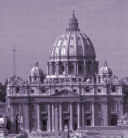 Saturday of the First Week of Lent (Ember Saturday)
Saturday of the First Week of Lent (Ember Saturday)
Station with San Pietro in Vaticano (St. Peter's in the Vatican):
The Station is in the Basilica of St. Peter in the Vatican, where the people would assemble towards evening, that they might be present at the ordination of the priests and sacred ministers. The original basilica was built by Constantine in 323 over the place where St. Peter was buried.
For more on San Pietro in Vaticano, see:
For further information on the Station Churches, see The Stational Church.





